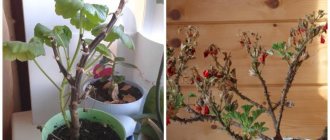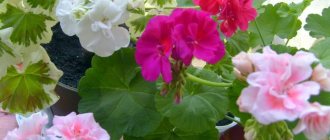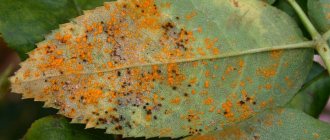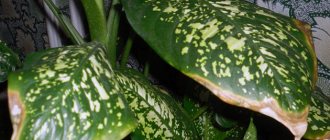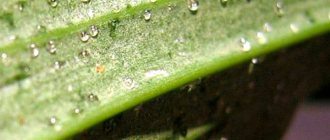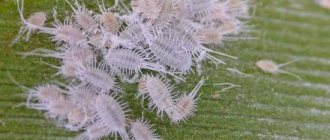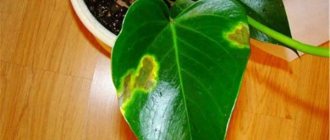Geranium is an unpretentious flower that requires the most minimal care. Usually this plant is placed on the windowsill, where it thrives, delighting with the aroma of flowering almost all year round. Despite its particular unpretentiousness, sometimes gardeners pay attention to the fact that geranium leaves turn yellow and dry out. Not knowing what the reason is, some begin to sound the alarm, others flood the flower with various antifungal agents, not realizing that this can lead to a worsening of the situation and blurring the overall picture of the problem.
You can save geraniums if you know the causes of the problem. And there can be a great many similar ones.
Mistakes when caring for indoor geraniums
Illiterate care is the main reason for the appearance of yellow leaves in geraniums. This is an unpretentious plant to grow, but the basic rules for its development must be followed. Knowing the typical mistakes, it is easier to understand what your favorite indoor flower needs.
Wrong capacity
The choice of a pot for pelargonium must be approached very carefully. Some novice gardeners wrongly believe that the roots need a lot of space. But this is not suitable for all plants.
Indoor geranium in a tight container will quickly fill the entire space with roots and the growth of the plant will slow down. As a result, the leaves will begin to turn yellow and dry out. Using a very large flowerpot is also not an option. In a spacious pot, pelargonium will begin to intensively grow its root system, devoting all its strength to this process. For this reason, flowering will be delayed.
Over a large area there is a risk of moisture stagnation, which will lead to the development of rot.
Lack or excess lighting
Pelargonium is a light-loving flower. It is better to place it on a windowsill where there is enough light. In the shade, a yellow edging will form on the leaves and they will begin to dry out. But direct rays of the sun are also detrimental to pelargonium. They cause brown burns.
Watering too much
Indoor geranium is a drought-resistant species, this should be taken into account when caring. It is enough to water once a week. During hot summers, the frequency of moisturizing can be increased. The plant does not tolerate excess moisture. A characteristic sign is the appearance of yellowness on the foliage.
Lack of regular watering
Indoor geranium is capricious regarding watering. It does not tolerate a lack of moisture and does not respond well to waterlogging. You need to find a compromise: water the soil when it dries 2.5 cm. If this is difficult to monitor, then mulching the soil would be a good option. Pine bark, peat, crushed stone, tea, moss, and marble chips are suitable for this. The time between watering will increase, there will be no risk of rot spreading, and yellowing of the leaves will be prevented.
Incorrectly selected soil
In order for pelargonium roots to grow well, you need a special loose, fertile soil mixture. You can buy it in the store. Soil collected in the yard or forest may be unsuitable for indoor geraniums and will cause poor development and lack of flowering.
Also read the article about varieties of pelargonium and proper care for it.
Increased air humidity
Not only the root system, but also the leaves are sensitive to excess water.
Do not spray the plant with a spray bottle. This will negatively affect the color of the greens; they may turn yellow.
Heat
Indoor geranium grows best at a temperature of +20 °C. High degrees cause yellowness on the leaves. This happens especially often in winter, when heating radiators strongly heat the air near the windowsill on which the plant stands. When it gets colder, the development of pelargonium slows down and flowering is delayed. She is preparing to die.
No fertilizer
Active growth and rapid flowering require good feeding. This requires iron, phosphorus, and potassium. Nutrients must be added regularly once a month. You can buy a universal mixture for indoor flowering plants with a low nitrogen content.
We recommend reading the article about why your pelargonium may not bloom.
Herbicide ingress
When the leaves of indoor geraniums turn yellow and dry, there is a possibility that chemicals, such as weed control drugs, will come into contact with the plant. Pelargonium is sensitive to household household hygiene and cosmetic products - air fresheners, hair sprays.
Drafts
Indoor geraniums are often placed on window sills. Not surprisingly, this beautiful plant is always pleasing to the eye. But regular ventilation harms the appearance of pelargonium. The leaves begin to turn yellow and dry out, and gradually they all fall off. You can correct the situation by choosing a place without wind.
Poor or no drainage
To remove excess moisture from the root system, the pot must have a drainage layer. In its absence, the process of decay begins, which gradually destroys the entire plant. Its beginning can be determined by the leaves. They begin to turn yellow for no apparent reason.
How to avoid the problem of yellowing leaves
By following a number of simple rules, you can enjoy the flowering and growth of geraniums.
These rules are as follows:
- Replant the plant as needed; choose a new pot just a couple of centimeters larger than the previous one, otherwise the geranium will not bloom for a long time.
- Place the flower in a well-lit place, but protected from direct sunlight and drafts.
- Water as needed, checking the soil beforehand.
- From time to time, fertilize the soil. During flowering, this manipulation is performed once every two weeks.
- In winter, protect the flower from cold and freezing of the root system.
- Inspect geraniums carefully to notice any pests or diseases.
So, when geranium leaves turn yellow, first figure out the reason. It is worth saying that by turning yellow leaves in autumn, the plant wants to show that a dormant period is ahead, so it does not need to be fed frequently (this is done once every 2-3 months), watered regularly, or disturbed in any other way. If you do everything right, in the spring geranium will delight you with the riot of its flowering.
Diseases and pests
If, with good competent care, geranium leaves still turn yellow, then the cause may be diseases of indoor plants.
Gray rot
Pathogen: Botrytis cinerea (gray botrytis). Lives in the ground from one to two years. Spreads by wind, with soil, water, and other infected plants.
Causes:
- moisture stagnation:
- high air humidity;
- excessive spraying;
- a large amount of nitrogen in the soil;
- poor ventilation.
The disease is characterized by damage to foliage. Areas with a velvety coating and brown spots form on it. The disease affects the lower leaves most severely.
First aid: treatment with fungicides (Fundazol, Vitaros).
Rhizoctonia rot
Pathogen: Rhizoctonia solani. Infection occurs through the soil.
Causes:
- excessive amount of fertilizing;
- exceeding the permissible temperature;
- excess moisture;
- light deficiency;
- poor ventilation;
- a difference of 6...8 °C between the temperature of the soil and the surrounding air.
The disease affects the roots and stems of the plant, causing depressed spots to appear on the stem. The fungus begins to spread over them (to a height of no more than 25 cm).
First aid: stop watering and treat with fungicides (Fundazol, Vitaros, Rovral).
Alternaria blight
Pathogen: Alternaria alternata. Infection occurs through the soil, especially under greenhouse conditions (warm and humid).
The reason is high humidity.
Yellow and brown spots with a light center appear on the leaves. At high humidity they are covered with dark velvet. Most often, the disease affects zonal pelargonium.
First aid: treatment with fungicides (Skor, Ridomil Gold, Rovral).
Verticillium wilt
Pathogens: Verticillium dahliae and albo-atrum. Lives in the ground for up to 15 years. Infection occurs through damaged roots during rooting of cuttings.
The disease is especially active in summer, when the weather is warm and the soil dries quickly.
It begins with yellowing of the lower leaves. Subsequently, the disease covers the entire plant. In severe cases, you have to throw away the pelargonium along with the soil.
First aid: maintaining proper soil moisture and treating with fungicides (Fundazol, Vitaros, Rovral).
Rust
Pathogen: Puccinia pelargonii-zonalis. Transmitted through other affected plants with water and air.
The onset of the disease can be determined by brown dots on the stem. Then the leaves begin to turn yellow. Gradually they all fall off.
First aid: reducing air humidity, stopping spraying, getting rid of diseased leaves, treating with fungicides (Topaz).
If indoor geraniums turn yellow, you need to inspect the plant to see if it has been attacked by parasites. They rarely attack pelargonium, since the strong specific smell repels them.
Pelargoniums are usually plagued by whiteflies. She lives and lays larvae under the flower. If the colony of pests grows to a large size, the leaves turn yellow or turn brown. You can see the whitefly with the naked eye. It is up to 3 mm in size with white wings.
When geranium leaves begin to turn yellow and curl inward, it is an aphid infestation. It is difficult to get rid of it, but it is possible. To do this, remove all affected parts of the plant, and then treat with Fitoverm or Mospilan.
We recommend reading an article about why indoor geranium leaves can curl and dry out and what to do about it.
Lack of nutrients in the soil
Incorrectly selected soil or depleted soil in a flower pot is the most common cause of yellowing geranium leaves. If there is a lack of at least one of the beneficial nutrients, the plant loses its decorative qualities, the leaves change color, then dry out and fall off. To maintain the natural color of leaf blades, sulfur, nitrogen, magnesium, zinc, copper, iron, phosphorus, boron and manganese are needed. Negative external changes in the plant will tell you which element it is missing:
- Gradual yellowing of the entire plant (stems, petioles and leaves) at the same time indicates a lack of sulfur;
- If yellowness spreads on older leaves (from the edge to the central part), this is a signal of nitrogen deficiency;
- Yellowing or chlorosis between the veins on older leaves is a magnesium deficiency;
- Yellowing young leaves with curling edges indicate a lack of zinc;
- The leaves become yellow-green from the base to the edges - a lack of copper;
- Yellowing between the veins on the surface of young leaves is a lack of iron;
- The upper leaves remain green, but the lower ones begin to turn yellow at the edges, and then gradually chlorosis spreads over the entire surface - this is a lack of phosphorus;
- The appearance of small yellowish spots on the surface of middle-aged leaves indicates a lack of boron;
- Dotted yellow spots gradually fill the entire surface of the leaf - this is a deficiency of manganese.
Chlorosis can be stopped only at the first signs and only in the earliest stages. To do this, it is recommended to urgently transplant the geranium into a new soil mixture with all the necessary nutritional supplements. Specialized stores offer a wide range of soil mixtures recommended specifically for growing geraniums. After some time, such mixtures also become depleted, so it is necessary to regularly add mineral fertilizers to the soil.
Mr. Summer resident informs: first aid for geraniums and prevention
Indoor geraniums with yellowed leaves can be saved. Tips for quickly helping pelargonium:
- when replanting, inspect the roots for rot or disease, if damaged, wash with a weak solution of potassium permanganate, and completely change the soil;
- a pot with a flower in autumn and winter is placed further from heating radiators, it can be taken out to a glazed balcony (if the temperature there does not drop below +12 °C);
- pour soft water over it, let it sit for a long time and add a pinch of citric acid or lemon juice (3-4 drops);
- constantly inspect for damage by insects and fungi, and take timely measures to get rid of them;
- the soil is chosen in the store; it is a universal soil for indoor plants;
- if the surrounding air is dry, do not moisten the pelargonium from a spray bottle; it is best to place a cup of water or wet expanded clay next to it;
- feed regularly, since the flower is sensitive to the lack of nutrients (choose complex fertilizers in the store);
- In order for pelargonium to bloom magnificently, pruning is done in the spring, leaving a few shoots;
- if the plant stretches to one side, the pot is turned to the sunny side with different sides;
- Before watering, loosen the soil; the root system of pelargonium needs oxygen;
- in winter, they carefully watch so that the leaves do not touch the cold glass, as a result they dry out, turn yellow and fall off prematurely;
- on a hot summer day on the sunny side, the window is shaded with a sheet of paper or a piece of gauze;
- if the window sill is cold in winter, to insulate the roots, place a wooden kitchen stand, a towel, and several layers of woolen fabric under the pot;
- if there is no drainage layer in the pot with geraniums, and replanting will not happen soon, then regularly pierce the ground in several places with a hot knitting needle;
- in winter, cover the batteries with a damp thick towel, this will get rid of the increased temperature in the room and too dry air for pelargonium on the windowsill;
- A good container for indoor geraniums is a ceramic pot. Porous clay allows air to pass through, excess water evaporates faster, and air flows to the root system.
Beautiful green leaves of pelargonium indicate the health of the plant and proper care. Changes in color indicate diseases, pests or bugs.
What to do if the plant withers
You can try to save pelargonium that is fading and shedding its leaves in the same way as another indoor plant, regardless of whether the main plant has a chance. To do this, you need to select a part of the flower that has a healthy appearance (for example, the top), cut it off and root it in water with the addition of a root formation stimulator (Kornevin, KorneStim, Heteroauxin). The second option is to immediately place the cutting in the soil.
- How to propagate pelargonium by cuttings - step-by-step master class with photos
Do you want to get several pelargoniums at once? The easiest way is cuttings. Step-by-step instructions with photos.
Is your pelargonium healthy? Take a closer look at the window pet in time!
Natural causes
The life cycle exists not only in humans and animals, it is also present in representatives of the flora. Plants also reach a certain age when some parts, namely the leaves, begin to die. Most often these are 1-2 leaves at the bottom of the plant. Yellowing continues gradually until it completely covers the entire surface. After this, the leaf dries out. This natural reason should not bother the grower, because the entire plant is not in danger. After trimming a dried or yellowed leaf, the geranium will remain just as attractive and will continue to grow and develop.
When is it too late to help?
- If the geranium has dried out, then the first thing you need to do is inspect its roots. If they are elastic and white, then all is not lost. You need to replant the plant in prepared soil - perhaps it can be revived. If the roots are limp and covered with dark spots, then the bush is unlikely to be saved.
- If the geranium has partially dried out, you can cut healthy cuttings, put them in water for germination, and then plant them.
- When the cause of drying is diseases or pests, then in case of severe damage it is better to give up trying to save the geranium. Often this is simply not possible. Pathogenic spores and parasite larvae remain deep in the soil and can be very difficult to completely remove.
Improper care of geraniums, first of all, affects the foliage - they begin to hurt and change color or curl. Why this happens and what to do when a problem occurs, read our articles.
Yellowing and drying of leaves occurs for a number of reasons, but if you know how to create conditions for a comfortable existence of the plant, then this problem will not bother you. If this does happen, then you shouldn’t despair - you need to give the plant a little time, and after a while the foliage will become beautiful and green again!
The plant has dried up: resuscitation at home
There are situations when the geranium has dried out completely. How to save a dried plant :
- Inspect the dried flower: if there is a living trunk left, then the geranium should be put away for the winter in a cool place. The stem may grow back in the spring.
- If the stem is dried, dig up the root and place it in water; if the root produces new roots, then plant it in the ground.
TIP : To create favorable growth factors for geranium and prevent its dryness and diseases, it is necessary to perform a set of preventive procedures.
Prevention measures:
- carry out careful timely transplantation into suitable pots;
- carry out moderate watering according to the degree of drying of the soil surface;
- establish that the geranium is located in a place protected from drafts;
- apply organic and mineral fertilizers (during the flowering period - twice a month);
- diagnose and eliminate pests;
- When yellow leaves appear, their timely removal is required.
Despite the unpretentiousness of geraniums, it takes some effort to grow beautiful, well-groomed plants. Any disease can be cured if the necessary measures are carried out correctly in time.
Plant buds can be helped to bloom. Even a dried flower can be revived . Having created the necessary conditions, the owner will be rewarded with an elegant, blooming space.
Pelargonium is sick: we diagnose, treat and revive bookmarks 5
This beautiful and unpretentious indoor, and if desired, garden plant with fragrant feathery or rounded leaves, with clusters of red or pink flowers, was loved by our great-grandmothers. We are, of course, talking about geranium, which is now more often called pelargonium. Previously, it was believed that this flower rarely got sick, and they didn’t bother with its treatment: after all, it’s very easy to grow a new bush from a cutting. Now pelargonists are actively discussing diseases and methods of treating their favorite plant at home, and everyone has a “green first aid kit.” What and why can indoor pelargonium be sick and how to help it?
Sunburn
Geranium tolerates direct sunlight and can be outdoors in the summer under the sun's rays. But the impact of such rays on a flower through a window glass leaves sunburn on the leaf plates. First, those leaves that are closest to the glass suffer, and sometimes even pressed against it. Yellow-brown spots appear on them. Such yellowing does not pose a threat to the life of the geranium, but its decorative qualities still suffer. After changing the growing location and pruning damaged shoots, the beauty of the geranium is gradually restored.
Home conditions for pelargonium
Pelargonium (aka geranium), which is grown on windowsills, is a native of the South African savannas. And like all Africans, she loves the sun and warmth very much, but has a negative attitude towards soil that is too nutritious and too wet. Rain is rare in the savannah, and the land there is poor.
In indoor floriculture, three types of pelargonium are known: zonal, royal (or royal) and ampelous. It is the zonal, or garden, geraniums that are planted in flower beds in the spring. They bloom for a very long time and reproduce without problems from cuttings. Royal pelargoniums are more whimsical. Their flowers are larger and more interesting than those of the zonal ones, but the flowering period is shorter and they are more difficult to reproduce. Ampelous geraniums are the most delicate and complex. But in general, pelargoniums are not very demanding and grateful flowers.
The characteristics of flowering southerners must be taken into account when growing them at home. Place pelargonium window sills on the south, east or west side. Plant it in a cramped pot so that it blooms better, give it not very nutritious soil with a good drainage layer.
Water rarely, but a lot, when it grows and blooms. But do not allow water to stagnate, remove excess water from the pan. In winter, only lightly moisten the soil; it should have time to dry out between waterings. There is no need to spray pelargonium; in nature it is not spoiled by high humidity. On the contrary, pubescent leaves can get sick if drops get on them. Be careful with fertilizing. Pelargonium can get sick from both lack of nutrition and excess. So keep your balance.
Blooming geranium needs fresh air all year round; ventilate the room where it grows. This is a good prevention of fungal diseases. In the summer, give the flower walks: put it in the fresh air or even plant it in open ground. The geranium will literally bloom there. In the fall, bring the whole plant or its cuttings home again.
Organize cool wintering, optimally from +10 to +15 degrees. And in winter, just as in summer, pelargonium needs plenty of light. If there is a deficiency, the leaves will be small, and flowering will be sparse or buds will not form at all. If there is not enough sun, artificial lighting (phytolamps, fluorescent or LED) will help.
Indoor geranium responds well to pinching and pruning. Form a fluffy bush in spring and summer, trim pelargonium for rejuvenation. And be sure to remove faded flower stalks so that new ones appear.
But don’t rush to transplant pelargonium from pot to pot. This plant is not prone to changing places. After relocation, she may turn yellow and become depressed so that resuscitation is required.
Phytocontrol measures
It is easier to prevent a disease than to cure it; this principle of prevention also applies to plants. And her main rule is hygiene. A plant free from diseases and parasites and clean soil will be the key to healthy pelargonium. A flower can pick up an infection or parasite anywhere: in a nursery, in a store, in the soil. To protect your green pets, introduce home phytosanitary control. These measures will ensure the safety of the plants.


